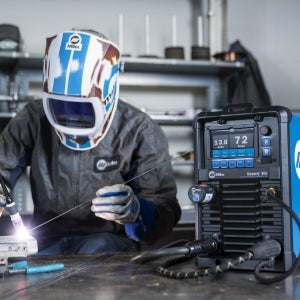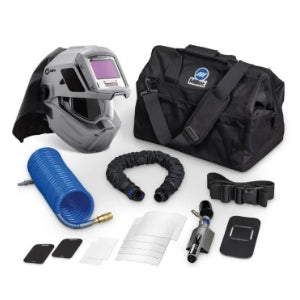As the winds whirled about and the seas rocked their boat with a chorus of thunder, sailors used to watch the top of their ship’s mast. They hoped to see a strange glowing light above, a good omen that the storm was about over. This phenomenon was known as St. Elmo’s fire. Interestingly, that same good omen is how modern plasma cutters work. You see, the heavily charged air from the storm would interact with the mast of the ship, creating a ball of plasma — the same plasma we use to cut through metal today. In this article, we'll explore the origins of plasma cutting, from the discovery of plasma to how the powerful force of electrical energy was harnessed into a welding tool.
Who Discovered Plasma?
While humankind has been exposed to plasma since the beginning of time, real understanding only started about a century ago. The first real recognition came from Sir William Crookes, a scientist with a curiosity as large as his incredible mustache. At the time of his discovery, Crookes called the strange substance “Radiant matter.” Interestingly, the name “plasma” was given to this 4th state of matter much later in 1928 because it looked like the plasma in our blood.
What Is a Plasma Cutting Machine?
Fast forward to 1950, when James Browning and Merle Thorpe began utilizing plasma as a method for heating metal. This innovative approach originated from the US Space program, where plasma was initially employed to simulate the extreme heat conditions experienced by rocket capsules during reentry. As early as 1953, Browning and Thorpe developed the first plasma torch, capable of generating an arc jet with temperatures exceeding twice that of the sun's surface. Their pioneering efforts led to the establishment of Thermal Dynamics, a company that remains prominent in the field of plasma-cutting technology.
Interestingly, while it was James and Merle who invented plasma cutting, they didn’t secure the first patent on plasma cutting, which was granted to Dr. Robert Gage at Union Carbide. In fact, Union Carbide would hold the patent for the next 17 years.
While they might not have roped in the first patent, Thermal Dynamics soon became one of the biggest players in plasma cutting equipment and research, securing patents on several improvements. Early machines were quite an investment, mostly geared towards large factories and nothing like the small, handheld versions we have today.
Understanding Plasma Cutting
A plasma-cutting machine utilizes a high-velocity jet of ionized gas (plasma) to cut through electrically conductive materials such as steel, aluminum, brass, and copper. The plasma-cutting process involves passing an electric arc through a gas (typically compressed air), transforming it into plasma. This superheated plasma, directed through a narrow nozzle, creates a focused and precise cutting flame that can easily slice through thick metals.
How Hot Can a Plasma Cutter Get?
A modern plasma cutter can reach extremely high temperatures, typically between 20,000°C (36,032°F) to 30,000°C (54,032°F). This is significantly hotter than the sun's surface, which has a temperature of about 5,500°C (9,932°F) at its visible surface. The intense heat generated by a plasma cutter is due to the ionization of gas (plasma) passing through an electric arc, creating a focused and powerful cutting flame capable of melting and severing electrically conductive materials like metal with precision and efficiency.
Applications of Plasma Cutting
Initially, plasma cutting machines were large-scale industrial tools, primarily used in factories for heavy-duty metal fabrication. Over time, advancements in technology have led to the development of smaller, more portable plasma cutters suitable for various applications:
- Metal Fabrication: Used extensively in metalworking industries for cutting, gouging, and piercing operations.
- Automotive Repair: Ideal for precise cutting of automotive body panels and frames.
- Construction: Used in structural steel fabrication and on-site metal installation.
- Artistic Metalwork: Popular among artists and sculptors for creating intricate metal designs.

Enter Hypertherm
In 1968, another huge name in the industry got its start when Dick Couch and Bob Dean founded Hypertherm. They had developed a way of radially injecting water into the plasma arc. This significantly compressed the arc, creating a more concentrated heat column that resulted in a much cleaner cut.
In the 1970s, Thermal Dynamics released the PAK 40, the first plasma cutter released as a single unit. It sold for $4,900 (or $33,400 in today’s money). And while improvements continued to be made, plasma cutters were still out of reach for most welders. In 1980, Thermal Dynamics’ PAK 5 sold for $2,950 ($9,880 in today’s money). While this was a significant difference, the PAK 3 brought an even more drastic change as the first handheld plasma cutter ever mass-produced.
In 1985, Hypertherm introduced its own handheld unit, the MAX 40. At this time, the plasma market was still quite niche, and the MAX 40 was considered a success, having sold 1,000 units in its first year. However, that all changed at the end of the decade.
The Plasma Market Explodes
In the 1990s, the plasma market exploded, growing by fifty times. During the next 20 years, plasma cutters became increasingly available to the everyday welder. While advances allowed plasma cutters to be more powerful, less costly, and more portable, there were several issues. Plasma cutters became somewhat controversial, with many welders feeling this “new, fancy cutter” had several problems compared to older cutting methods like Oxy Acetylene or a good, old-fashioned grinder.
Shop Plasma Cutters at Welding Supplies From IOC
Today, plasma cutters available to the public have made extensive strides. While some welders are still a little weary, plasma cutters have become common equipment, capable of creating cleaner cuts than any other type of machine. If you haven’t seen the capabilities of modern plasma cutters today, you owe it to yourself to check out how much they’ve improved. Check out our store to shop the best plasma cutters on the market, as well as other top welding equipment.





